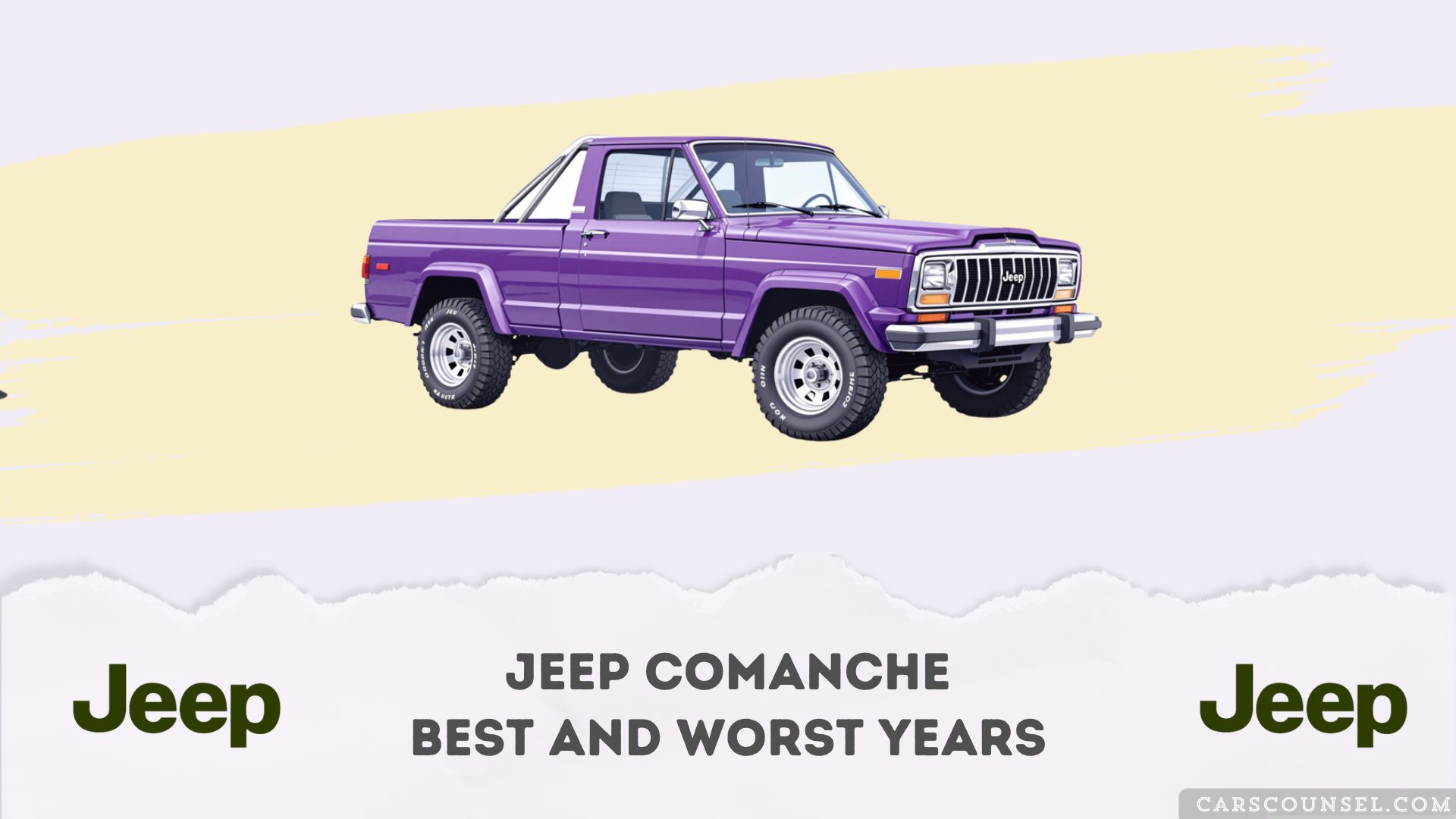As you consider purchasing a Jeep Comanche, it’s essential to know which model years to focus on and which to avoid. You’ll want to steer clear of the 1986 and 1987 models, plagued by unreliable engines and problematic transmissions.
Certain 1990 models also raise red flags. But don’t worry, there are gems to be found. The 1992 model, with its 4.0L engine and AX-15 transmission, is a reliable option that’s worth exploring further.

Quick Navigation
Key Takeaways
- The 1986 model year is the worst due to the unreliable GM V6 engine.
- The 1987 model year is also problematic due to the BA-10/5 transmission.
- The 1992 model year is a good option, featuring the reliable 4.0L engine and AX-15 transmission.
- The 1987-1990 models, known as “Renix Jeep”, are a good choice for a build project.
- The 1990 model year is the weakest, with the AX-15 and Renix combination being the only exception.
Comanche Years and Models
When considering a Jeep Comanche, you’ll want to pay attention to the year, as some are better than others.
The 1986 model year is one to avoid due to its unreliable GM V6 engine option.
The 1987 model year introduced the AMC six-cylinder engine but came with the problematic BA-10/5, making it another year to avoid.
However, the 1987-1990 models, referred to as “Renix Jeep”, are a good choice for a build project.
If you’re looking for a reliable model, the 1992 model year is a good option, with its 4.0L engine and AX-15 transmission.
Transmission Options
When shopping for a Jeep Comanche, you’ll want to focus on good transmission choices, such as the AX-15, which was available from 1989.5 to 1993.
Meanwhile, it’s best to avoid the BA-10/5 transmission, which was available from 1987 to 1989 and isn’t considered a reliable option.
Good Transmission Options
You’ll find several good transmission options available for your Jeep Comanche.
The AX-15 transmission, offered from 1989.5 to 1993, is a reliable choice.
For four-cylinder engines, the AX-4/5 transmission provides a decent option.
If you have a 2.8L V6 engine, the Warner T5 transmission is a good choice.
If you prefer an automatic transmission, the AW4 is a reliable option.
With these options, you’ll have a smooth and reliable ride.
BA-10/5 and AX-15
The Jeep Comanche’s transmission options include the BA-10/5, which unfortunately has poor performance and reliability issues, making it a transmission to avoid.
You’re better off opting for the AX-15 transmission, introduced in 1989, which is known for its reliability and performance.
Available from 1989.5 to 1993, making it a good choice for models within this timeframe.
The AX-15 transmission replaced the BA-10/5, addressing the reliability issues of its predecessor.
With the AX-15, you can enjoy a smoother ride and fewer transmission-related headaches.
Engine Options
For those in the market for a Comanche, choosing the right engine can be a pivotal crucial decision.
You’ll want to weigh the AMC four-cylinder engine, known for its good mileage. The AMC six, available from 1987, is also a good option.
The 4.0L engine is a good choice, known for its reliability and power. However, steer clear of the GM V6 engine, available for some models, as it’s known for poor performance.
With these options in mind, you’ll be well on your way to finding the right Comanche for you.
Comanche Features and Options
Now that you’ve selected the right engine, it’s time to think about the features and options that’ll make your Comanche truly capable. The towing package is a great option, increasing payload capacity and adding a better rear axle.
| Feature | — | Benefit |
|---|---|---|
| Towing Package | D44 rear axle | Increased payload capacity |
| 1-ton Package | Additional leaves | Heavier load capacity |
| Metric Ton Package | Extra overloads | Heavier load capacity |
| ARB/Detroit Locker | Better traction | Improved off-road capability |
| Towing Package | Increased payload capacity | Better rear axle |
Model Year Considerations
When selecting a Jeep Comanche, you’re faced with distinct model year variations that can significantly impact your ownership experience.
The 1986 model year stands out as the only year with a long bed and unique firewall and radiator support areas, making a 4.0 swap challenging.
From 1987 to 1992, short beds were offered, with 1987-1990 models featuring the Renix fuel injection system.
The 1991-1992 years are the rarest and most valuable.
The 1990 model year is the weakest, while the 1990 model is the only year with an AX-15 and Renix combination.
Firewall Clearance and Swap Considerations
As you plunge into the engine swap process, you’ll encounter a critical aspect: firewall clearance.
Guarantee you have sufficient space between the engine and the firewall to prevent overheating, electrical issues, and even fires.
Consider the following key points for a successful swap:
1. Engine Dimensions
Verify the engine’s length, width, and height fit within the Comanche’s engine bay.
2. Firewall Modifications
Determine if you need to cut, bend, or modify the firewall to accommodate the new engine.
3. Clearance Checks
Perform thorough clearance checks to avoid any potential issues before starting the swap process.
Member Opinions and General Information
You’ve likely heard mixed opinions about the Jeep Comanche’s model years, and for good reason.
Some Jeep enthusiasts prefer the 1990 models, boasting the AX-15 transmission and Renix fuel injection system.
However, not all 1989 models have the AX-15 transmission, making verification vital.
Opinions vary, with some loving the 1988 model, while others swear by the 1990 model.
Ultimately, the best year for you depends on your preferences, such as engine and transmission options, and desired features like the towing package.
The History Behind The Jeep Comanche Models
The Jeep Comanche‘s introduction in 1986 marked a strategic move by AMC-owned Jeep to tap into the American and Japanese markets.
You might be surprised that the Comanche was built on the Jeep Cherokee to reduce manufacturing costs.
Despite its remarkable accomplishments, including breaking nine records, the Comanche was abandoned due to corporate acquisition.
- It was produced for only seven years, from 1986 to 1992, with a total production of only 200,000 units.
- The Comanche’s first year was successful, with the 2.5-liter four-cylinder engine capable of up to 21 mpg city and 25 mpg highway.
- The 4.0-liter inline-six engine was the most durable, with several units being driven over 250,000 miles without significant problems.
Fuel Efficiency
You’ll find that the Jeep Comanche’s fuel efficiency varies depending on the engine.
The 2.5-liter four-cylinder engine, for instance, gets up to 21 mpg and 25 mpg in city and highway driving, respectively.
When you look at the 4.0-liter straight-six engine, it manages up to 16 mpg in the city and 20 mpg on the highway.
City MPG Ratings
Fuel efficiency was a notable aspect of the Jeep Comanche’s performance, with the 2.5-liter four-cylinder engine delivering up to 21 mpg in urban driving conditions in 1986, a respectable figure for a pickup truck of its time.
You’ll notice that the Comanche’s city MPG ratings varied throughout its production.
Here’s how they break down:
- 21 mpg: The highest city MPG rating, achieved by the 2.5-liter four-cylinder engine in 1986.
- 18 mpg: The lowest city MPG rating, achieved by the same engine at the end of its production.
4. 16 mpg: The rating achieved by the 4.0-liter six-cylinder engine.
Highway MPG Ratings
Comanche owners got a boost on long trips with the truck’s highway MPG ratings, which rivaled those of its competitors.
The 2.5-liter four-cylinder engine, for instance, achieved up to 25 mpg highway in its prime. Later models saw a slight drop to 22 mpg highway.
The 4.0-liter straight-six engine, on the other hand, reached up to 20 mpg highway. While not exceptional, these figures were on par with other pickup trucks of the time, such as the Ford Ranger and S-10.
You can expect decent mileage for a vehicle of its era.
Horsepower and Torque Output
The Jeep Comanche’s engine lineup kicked off with a 2.8-liter V-6, producing 115 horsepower and 150 pound-feet of torque in the 1986 model year.
You’ll notice that the horsepower was relatively modest, but it was just the beginning.
- In the 1986-1987 model, a 2.1-liter turbodiesel engine was introduced, with 85 horsepower and 132 pound-feet of torque.
- The 4.0-liter inline-six engine, which produced 173 horsepower and 220 pound-feet of torque, made its debut in the 1987 model year.
- The engine saw its final update in the 1991 model year, reaching 190 horsepower and 225 pound-feet of torque.
Durability and Lifespan
You’ll find that the Comanche’s engine longevity is impressive, with the 4.0-liter inline-six engine being a standout in terms of durability.
In fact, many of these engines have been known to last well beyond 250,000 miles without major issues.
As you research, you’ll discover that certain engine options are more durable than others, and understanding these factors can help you make an informed decision.
Engine Longevity Factors
How far can a Comanche’s engine really go? You’ll be surprised to know that the 4.0-liter inline-six engine can go a long way.
In fact, many Comanches with high mileage, such as 250,000 miles, are still in good condition.
- Robust design and construction, making it a desirable option for those seeking a long-lasting engine.
- Inexpensive replacement parts, with many components shared with the Cherokee, and a large aftermarket supply of accessories.
- Ability to withstand daily commuting and heavy use, including large item transportation, making it a reliable choice for daily driving.
The best year for the Comanche is certainly one with this durable engine, ensuring a long and trouble-free life of your vehicle.
Durable Engine Options
When shopping for a Jeep Comanche, you’re likely looking for an engine that can keep up with your active lifestyle.
The 4.0-liter inline-six engine is the most reliable and durable choice, with many models reaching over 250,000 miles without major issues.
Improved in 1991-1992, it offers 190 horsepower and 225 pound-feet of torque, making it a popular choice.
In contrast, the 4.0 GM V6 engine is considered poor quality and the AMC 242ci I6 is less desirable.
The 4.0-liter inline-six engine is a significant improvement over the 2.8 GM V6 engine, making it a better option for you.
Lifespan of Engines
The Jeep Comanche’s durability is a significant factor in its engine lifespan, and its 4.0-liter inline-six engine is a tribute to this.
You’ll be pleased to know that this engine option has been known to last well over 250,000 miles without major issues.
- Low maintenance costs: Replacement parts are inexpensive due to the abundance of Cherokee components.
- Reliable daily driver: The Comanche’s durability makes it suitable for daily commuting and hauling heavy loads.
- Powerful performance: The 4.0-liter inline-six engine received a horsepower boost in the 1991-1992 models, making it a desirable option.
When looking at performance cars, make sure to check out our guides on models like the Jeep Gladiator, Jeep Grand Wagoneer, Jeep Compass and Jeep Commander. Knowing which model years to target and which to avoid is crucial. Our expert reviews break down these models, providing insights into the years that are celebrated for their engineering excellence and driving satisfaction, as well as those that are best to avoid due to potential issues.

